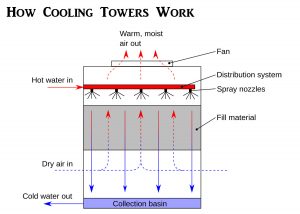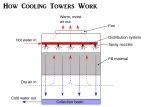
Cooling water tower system. Maybe some of us didn’t know what it is or maybe we even rarely heard about it or even see it. So before we talk about the chemicals used in it, we should know what cooling water tower system is, so that we can understand easier then.
Cooling water tower system is a system or an arrangement of technologies in order to keep your cooling tower feed water and circulatory in a good condition, by removing impurities which could cause damage to your cooling water tower system. Cooling tower water system also used to lower the hot water temperature which usually used in industries, factories, buildings and such.
A cooling water tower system used in many industries, because it could control :
- Alkalinity: the capability of water to neutralize acid
- Chlorides: a chemical compound which formed from chlorine elements, an anion which formed when gains an electron. Chlorides is corrosive to metal.
- Hardness: the quality or condition of being hard, it is the take role to exchange heat
- Iron: Iron, a chemical element with symbol Fe and atomic number 26. It is the most common metal that you can find on our daily life easily. It’s in our spoon, it’s in our car’s body, and it’s even in our body. In cooling water tower system, when iron combined with phosphate, it will make corrosion and make foul equipment.
- Silica: Silica is the other names of silicon dioxide. It is a silicon with formula SiO2. Silica has lots of uses such as, for cosmetics industry, food industry, pharmacy industry, and much more. We can find silica easily in quartz, a mineral which composed of silicon and oxygen, besides it also the second most abundant mineral on earth
- Sulfate: Sulfate is a chemical substance with SO42- formula. Sulfate involved in climate change, for example, sulfate is commonly found in rain, because sulfate increase acidity to atmosphere and form acid rain. Sulfate not just contributes in climate changes, but it also take part in building industry, such as gypsum industry.
How does it work?
Every cooling water may not always be the same, because it has lots of types, such as crossflow cooling tower, counter flow cooling tower, factory assembled cooling tower (FAP) factory assembled product. It’s all depends on how an industries or companies want it to be arranged. However, it does still work with the same principle which usually called as “evaporative cooling”.
Here are how evaporative cooling works :
- Hot water which usually caused by air conditioning condensers are pumped to the top of the cooling water tower.
- The water then distributed by cooling water tower nozzles to the fill deck/wet deck.
- By spraying the water, it will slow down the water flows and make the water and air contact to each other even longer.
- The longer it gets, the better it is. During the time air and water contacted, a small amount of water evaporates
- Evaporation will create an action of cooling and cool down the water temperature.
- It will repeated over and over again.
Chemicals in Cooling Water Tower System
In order to control everything stable and make water tower treatments maintenance cost way cheaper, every cooling water tower system needs chemicals substances to help. Chemicals used in cooling tower water treatment are:
- Bicarbonate
Bicarbonate as known as Hydrogen Carbonate is a chemical compound with HCO3- formula. We can usually find bicarbonate commonly in sodium bicarbonate form, which is in baking soda. In cooling water tower system, bicarbonate used for corrosion inhibitors. It is to neutralize acidity and protect metal components.
You might want to read : Uses of Sodium Bicarbonate in Daily Life
- Bromine
Bromine is a chemical element with symbol Br and atomic number 35, It is commonly used as an insecticides, which helps lots of farmer in keeping their crops clean from insects. In cooling water system, bromine also helps people to keep their cooling water tower system clean by being as an algaecides and biocides. It works to prevent the growth of microbes.
You might want to read : List of Banned Insecticides in India – Harmful Compounds
- Phosphoric acid
Phosphoric acid is a mineral with H3PO4 formula. It is commonly found in fertilizers in a form of salt, such as ammonium phosphate, calcium phosphate, etc. Phosphoric is an essential plant nutrient which is taken by plant’s roots and transferred it to its whole body. In cooling water tower system. It works to control pH of water and works as scale inhibitors to prevents the deposits of lime scales.
Chemical addition
Meanwhile, there are some typically chemicals added to this process, such as:
- Corrosion Inhibitors: This is needed to neutralize the acidity. For example, the industry uses bicarbonates to protect the metal components.
- Scale Inhibitors: Used to reduce and prevent the forming scale in contaminants, so that pipes can work well, water tower treatments usually use phosphoric acid to be the scale inhibitors. There are some factors which are needs to be weigh, such as efficiency, stability, compatibility, and of course cost.
- Algaecides and Biocide: This is used to prevent the microbes and biofilm grow. For example, they use bromine compound.
Meanwhile, many chemicals used on this water treatment can be so expensive.
Thus, that’s all the chemicals used in cooling tower water treatment.
You might want to read : Differences between Acid, Base and Salt
Cooling Water Tower System Benefits
There are lots of advantages when industries or companies are using cooling water tower system. Its benefits are:
- Optimized water usage
- Improved heat transfer efficiency
- Decreased energy use and maintenance cost
- Minimizing the risk of bacteria
- Great bacteria control
- Lower the water heat temperature
Meanwhile, that’s all the material about chemicals used in cooling tower water treatment.

